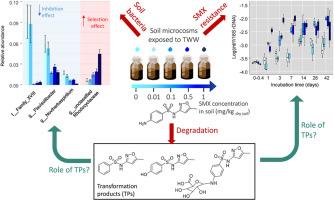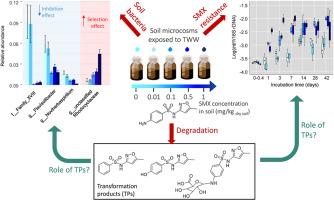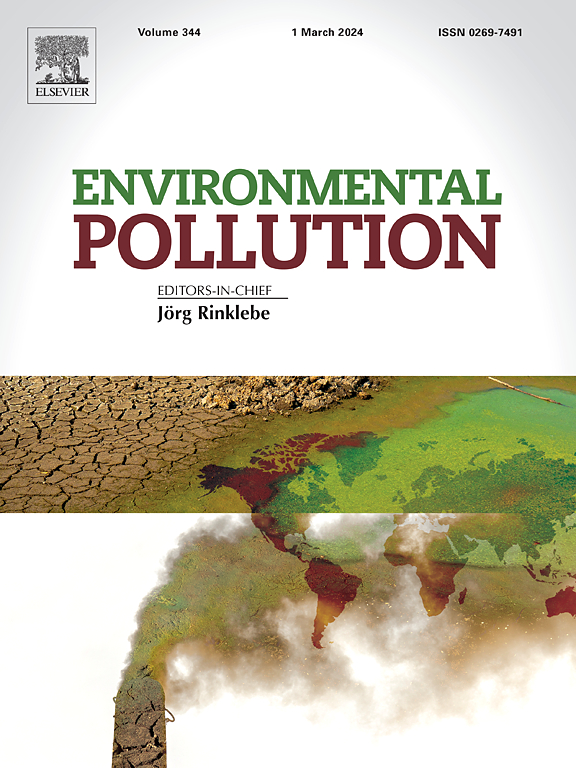Temporal dynamic of soil microbial communities and antibiotic resistance markers exposed to increasing concentrations of sulfamethoxazole
IF 7.6
2区 环境科学与生态学
Q1 ENVIRONMENTAL SCIENCES
引用次数: 0
Abstract
The reuse of treated wastewater (TWW) for irrigation is widely applied to alleviate pressure on freshwater resources. However, TWW contains antibiotics that once in soils, can exert selective pressure, promoting the emergence and spread of antimicrobial resistance (AMR) in the environment. Current environmental risk assessments for antibiotic residues rely on indicators such as Predicted No Effect Concentrations (PNECs), usually determined in liquid media. These PNECs aim to predict antibiotic concentrations that may promote resistance in the environment. Given the complexity of soil matrices, few studies have established PNEC values for soil, which likely differ significantly from aquatic environments.
To address this gap, we developed a simplified experimental model using soil microcosms irrigated with TWW and the antibiotic sulfamethoxazole (SMX) to estimate threshold concentrations favouring resistance transfer or/and emergence within the soil microbiome. We identified SMX concentrations between 0.01 and 0.1 mg/kgdry soil that likely increased the abundance of sulfonamide resistance genes in soil. A time window of 1–7 days post-exposure showed a temporary rise in sul1 and intl1 gene abundance (over 1 log/soil 16S rDNA), the appearance of SMX transformation products, and an increase in some Rhodocyclaceae. After 1.5 months of incubation and complete SMX transformation, the relative abundance of sul1 and intl1 remained about 0.5 log higher than in SMX-free controls and soils with SMX levels below 0.1 mg/kg dry soil. A persistent transformation product, 4-N-glucuronide-SMX, was also observed.
Here, the estimated PNEC for SMX in soil, between 0.01 and 0.1 mg/kg, exceeds typical SMX concentrations found in soils exposed to TWW. This may suggest low impact on resistance selection for this compound in the context of TWW exposure. However further studies on other soils, water, and antibiotics need to be conducted to expand our knowledge on soil PNECs.


暴露于浓度不断增加的磺胺甲噁唑的土壤微生物群落和抗生素耐药性标记的时间动态变化
将处理过的废水(TWW)回用于灌溉已被广泛应用,以减轻淡水资源的压力。然而,废水中含有抗生素,一旦进入土壤,就会产生选择性压力,促进环境中抗菌药耐药性(AMR)的产生和传播。目前的抗生素残留环境风险评估依赖于预测无效应浓度 (PNEC) 等指标,这些指标通常在液体介质中确定。这些预测无效应浓度旨在预测环境中可能产生抗药性的抗生素浓度。鉴于土壤基质的复杂性,很少有研究确定土壤的预测无效应浓度值,这可能与水生环境有很大不同。为了弥补这一不足,我们开发了一个简化的实验模型,利用灌溉了 TWW 和抗生素磺胺甲噁唑(SMX)的土壤微观模型来估计有利于土壤微生物群中耐药性转移或/和出现的阈值浓度。我们发现 0.01 至 0.1 毫克/千克干土壤中的 SMX 浓度可能会增加土壤中磺胺抗性基因的丰度。接触后 1 到 7 天的时间窗口显示,sul1 和 intl1 基因丰度暂时上升(超过 1 log/soil 16S rDNA),出现了 SMX 转化产物,一些 Rhodocyclaceae 也有所增加。经过 1.5 个月的培养和 SMX 完全转化后,sul1 和 intl1 的相对丰度仍比不含 SMX 的对照组和 SMX 水平低于 0.1 毫克/千克干土的土壤高出约 0.5 个对数值。在此,土壤中 SMX 的估计 PNEC(0.01 至 0.1 毫克/千克)超过了暴露于 TWW 的土壤中 SMX 的典型浓度。这可能表明,在接触 TWW 的情况下,该化合物对抗性选择的影响较小。不过,还需要对其他土壤、水和抗生素进行进一步研究,以扩大我们对土壤 PNEC 的了解。
本文章由计算机程序翻译,如有差异,请以英文原文为准。
求助全文
约1分钟内获得全文
求助全文
来源期刊

Environmental Pollution
环境科学-环境科学
CiteScore
16.00
自引率
6.70%
发文量
2082
审稿时长
2.9 months
期刊介绍:
Environmental Pollution is an international peer-reviewed journal that publishes high-quality research papers and review articles covering all aspects of environmental pollution and its impacts on ecosystems and human health.
Subject areas include, but are not limited to:
• Sources and occurrences of pollutants that are clearly defined and measured in environmental compartments, food and food-related items, and human bodies;
• Interlinks between contaminant exposure and biological, ecological, and human health effects, including those of climate change;
• Contaminants of emerging concerns (including but not limited to antibiotic resistant microorganisms or genes, microplastics/nanoplastics, electronic wastes, light, and noise) and/or their biological, ecological, or human health effects;
• Laboratory and field studies on the remediation/mitigation of environmental pollution via new techniques and with clear links to biological, ecological, or human health effects;
• Modeling of pollution processes, patterns, or trends that is of clear environmental and/or human health interest;
• New techniques that measure and examine environmental occurrences, transport, behavior, and effects of pollutants within the environment or the laboratory, provided that they can be clearly used to address problems within regional or global environmental compartments.
 求助内容:
求助内容: 应助结果提醒方式:
应助结果提醒方式:


